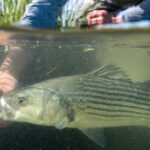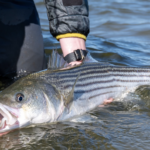
What to Watch for: ASMFC Spring Meeting
The Atlantic States Marine Fisheries Commission (ASFMC) will gather in Arlington, Virginia this week for the
Any passionate angler knows how essential an abundant forage base is for healthy and productive fisheries. “Find the bait, and you’ll find the fish,” is generally a pretty safe bet regardless of what you’re fishing for. ASGA strongly believes in forage fish conservation and works to improve fisheries management for many of these foundational species. For example, we were heavily engaged in developing Ecological Reference Points for menhaden—the idea that fishery managers leave enough menhaden in the water to sustain predator fish—and we’ve advocated for precautionary management of Atlantic Mackerel, a species struggling to rebuild. Today we’re going to dive into the status of another essential forage species, the Atlantic Herring, and efforts to reestablish a management tool to protect the species’ inshore abundance and prevent user conflicts with large-scale commercial fishing gear.
The New England Fishery Management Council is working to conserve Atlantic herring in inshore waters, so that diverse user groups are protected from the effects of the herring midwater trawl fishery. Atlantic Herring (also known as sea herring, locally up in New England) are managed by the NEFMC (the ASMFC manages the inshore fishery 0-3 miles from shore) and are currently at extremely depleted levels and in a rebuilding plan. Sustained poor recruitment is the biggest current challenge to successful rebuilding, but overfishing in the past certainly played a role in Atlantic herring’s current status.


Between 2015 through 2018, recognizing the benefits of herring available inshore and the incredible efficiency of the midwater trawl fleet’s ability to remove large volumes of this key forage species, the NEFMC began to develop an MWT exclusionary zone through Amendment 8 to the Atlantic Herring Fishery Management Plan (Final Environmental Impact Statement). The goals of this action were to:
Recreational and commercial fishing circles and various environmental organizations alike had long sought to constrain the outsized direct and indirect impacts of this fishery. Truly, the MWT fleet and gear-type are ocean raiders. Their ability to remove huge masses of herring and mackerel as well as incidentally caught species (river herring and shad, for starters, but the list goes much further) is, brutal.
Throughout Amendment 8’s development, a group of very diverse stakeholders coalesced around the buffer zone idea; inshore recreational anglers, small boat commercial interests, environmental organizations, whale-watching groups, and others engaged and shared their support. Don’t believe me—just take a look at the public comment summary from the A8 Draft Environmental Impact Statement. This same diverse support was also evident at the New England Council, which has historically been a more commercially oriented body, as the final vote for this action was nearly unanimous. In October 2018, the New England Council approved a combination alternative that resulted in a year-round 12nm Midwater Trawl Exclusionary Zone from the US-Canada border down through Connecticut and a 20nm buffer zone east and southeast of Cape Cod. NOAA Fisheries approved and implemented the rule in January 2021.

No matter how popular and widely-supported this action was (or how teeming with life the inshore tuna grounds out East have been the past couple of years), a Federal Judge vacated the MWT buffer zone because the “localized depletion” rationale was unjustifiable. NOAA Fisheries did not appeal the judgement. So, last summer (2022), the MWT buffer zone was invalidated. This was a huge blow to the hundreds, if not thousands, of dedicated stakeholders and advocates that fought to establish this common-sense approach to protect the inshore forage base and related businesses.
In any event, for the better part of a year, advocates and the NEFMC have been working towards reestablishing the MWT buffer zone by shifting the rationalization from one centered on “localized depletion”—which again, we do not have the science or data to support, and the Federal Judge based his decision to overturn the rule on—to one centered around user conflict.
If you talk to any bluefin tuna captain up in the Northeast, you will quickly realize a couple of things. This fishery is incredibly dependent upon forage availability. The tuna go where the bait is, simple as that. Additionally, you may hear how quickly a wide-open tuna bite will be killed by MWT vessels towing football-field-sized nets through an area. The ecological destruction this fleet is capable of is almost unimaginable. Those same previously productive tuna grounds become a barren stretch of ocean overnight. And while I explicitly mentioned tuna captains, the same disruption applies to whale-watching businesses, recreational anglers, shoreside fishing-related businesses and anyone else who depends on and cherishes a productive marine ecosystem.
While most anglers understand the concept of localized depletion of a forage resource as being a real, undeniable fact, it is unjustifiable and moot in the eyes of a court. So, let’s explore user conflict. As I mentioned above, this specific gear type has such an outsized impact. For example, there are very few permitted MWT vessels. Why are their harmful operations more important than the thousands of distributed stakeholders who rely on healthy, abundant forage populations? You cannot tell me that it is fair or equitable to hundreds of tuna boats fishing on Jefferies Ledge or east of the Cape that have their fishery completely disrupted by several MWT vessels wiping out the area’s forage population and killing the bite.
Atlantic Herring, much like any natural resource, are a PUBLIC resource that need to be shared to produce the greatest benefit to the nation. Now for some fisheries, that benefit is removals and large scale directed harvests, but other times that benefit is widely distributed among stakeholders (including ecosystem considerations). Landing herring is important—one of the most lucrative fisheries in the United States—Maine Lobster—relies (less so these days) on herring for bait. The contention here is not to prohibit all herring landings—no, that is totally irrational—the need is push the destructive and highly efficient MWT gear further offshore. where there will be less conflicts with other users.
The harvest potential that MWT gear has to remove incredible amounts of a species is no place for inshore/nearshore waters where smaller boats and other fisheries operate (whereas 100+ foot MWV vessels CAN safely operate 20 miles offshore). It’s no wonder why most states in New England prohibit or strictly regulate this gear type in state waters: it’s destructive and benefits so few to the detriment of the resource and the vast majority of stakeholders.
A core tenet of ASGA’s philosophy is accountability: for commercial and recreational sectors. The approval of the first buffer zone a couple of years ago was a big step toward holding this fishery accountable so that it doesn’t inequitably affect and harm other interests. However, in addition to the MWT exclusionary zone rule’s vacation, the U.S. Supreme Court is set to hear two herring-related cases (the cases are about NOAA requiring industry-funded monitoring on the herring industry, but it’s really about the Chevron Doctrine, which gives federal agencies deference to develop regulations if the law is ambiguous). NOAA Fisheries may not always implement rules you agree with but they do the best they can with the tools available (including a Magnuson-Stevens Act in need of an update, but I digress). Should this case, which again is not really about fisheries or the herring resource, receive an unfavorable decision, the Agency’s ability to sustainably manage fisheries according to the best available science will be severely curtailed, possibly threatening the long-term abundance and health of our marine resources.

ASGA has been engaging on the MWT issue and we will continue to advocate for better business through conservation. The NEFMC’s Herring Committee is set to consider how to move forward with MWT buffer zone later this week (June 22nd). You can review meeting materials here. Some Plan Development Team and Advisory Panel meetings have already occurred, and as much as I hate to say it, they have not gone well. By leaning in on the Court’s decision and localized depletion arguments, commercial herring fishing interests are effectively disrupting progress. Hopefully, the Herring Committee and full Council can remain on track and craft a durable rationale to reestablish this effective and widely supported Inshore Midwater Trawl buffer zone.
Stay tuned on this issue, because it’s really just heating up. We’ll need a lot of support at the Council to reestablish the inshore Midwater Trawl Buffer Zone and prevent conflicts with the thousands of fishing-related businesses impacted by this harmful gear.
Header Photo Credit: Vinit Vispute

The Atlantic States Marine Fisheries Commission (ASFMC) will gather in Arlington, Virginia this week for the

Consistent spawning production is paramount to a fishery’s long-term health. Many environmental factors are suspected

While the ASGA team is extremely proud of the community we’re building with the Guide

Feature Image: A false albacore being landed off Jupiter Florida by the Cheeky Fishing team,
We rely on our members and donations to keep fighting for a sustainable tomorrow in marine conservation.
By using this website, you agree to our use of cookies. We use cookies to provide you with a great experience and to help our website run effectively. To learn more, please review our privacy policy.